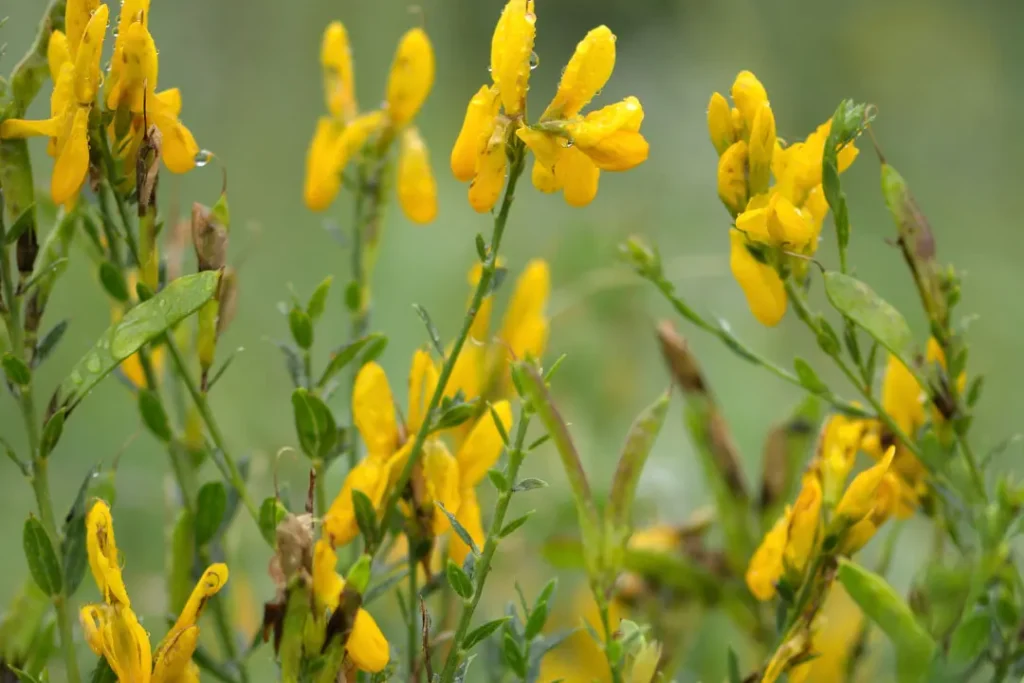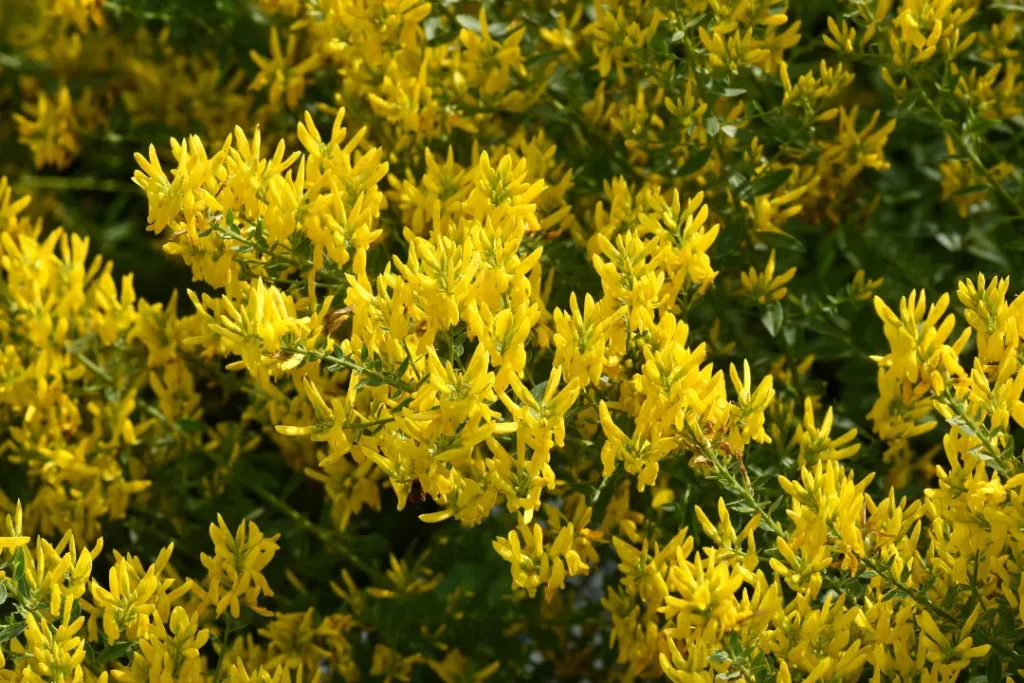The perennial plant known as dyer’s broom (genista tinctoria), dyer’s greenweed, or woadwaxen, has a long history of use in traditional medicine and usage as a source of natural dye. Dyer’s Broom has its origins in Western Asia and Europe and is known for the vivid yellow dye produced from its blooming stems. While dyer’s broom has a traditional importance as a source of dye, its therapeutic benefits are growing scientific interest. To fully understand dyer’s broom’s potential as a dietary supplement, this article will examine the plant’s chemistry, health advantages, ideal dose, potential side effects, and interactions with other substances.
You May Also Like:
Cnidium: Benefits, Dosage, Side Effects, Drug Interactions, and Other Important Information
Chymotrypsin: Benefits, Dosage, Side Effects, Drug Interactions, and Other Important Information
Dyer’s Broom: Benefits, Dosage, Side Effects, Drug Interactions, and Other Important Information is an original (NootroPicsPlanet) article.
The Nature of Dyer’s Broom
Dyer’s Broom is a tough plant that thrives in sunny places with chalky, alkaline soil. Its blossoms have a high concentration of flavonoids, giving them a brilliant yellow hue. Typically, blooming branches from plants are taken in the summer when they have fully bloomed and can be utilized for medicinal purposes.
Health Benefits of Dyer’s Broom
Throughout history, dyer’s broom has treated many illnesses. It can be used as a moderate diuretic or as a treatment for kidney stones, gout, and rheumatism. Its variety of uses shows that the plant has a varied profile of bioactive substances with potential medicinal use.
One of dyer’s broom’s proven health advantages is its diuretic properties, which can be helpful for illnesses like hypertension and edema, where lowering extra bodily fluid could be advantageous. Traditional medicine has employed dyer’s broom to reduce rheumatic pain. Current research shows that it may have anti-inflammatory properties that can explain this use.

Chemistry of Dyer’s Broom
The pharmacological properties of dyer’s broom are the compound mix that makes up its rich and diverse chemical composition. The plant has a wide distribution of flavonoids, phenolic acids, and tannins in its leaves, flowers, and stems.
Notably, the plant’s yellow hue is a result of the flavonoids. The two isoflavone subgroup members genistein and genistin make up the majority of the flavonoids in dyer’s broom. These flavonoids are said to have anti-inflammatory, antibacterial, and antioxidant effects.
Additionally, dyer’s broom contains phenolic acids including caffeic acid and ferulic acid. These substances are known for having potent antioxidant properties that can shield the body from harm brought on by oxidative stress. Another essential component of dyer’s broom is its astringent tannins.
Physiological Properties of Dyer’s Broom
Dyer’s broom’s flavonoids, phenolic acids, and tannins interact with numerous biological processes in the body and are chiefly responsible for its physiological benefits.
Many cellular functions, including oxidation and inflammation, are modulated by flavonoids like genistein and genistin. These substances have antioxidant and anti-inflammatory properties by scavenging free radicals and inhibiting the generation of inflammatory mediators like cytokines.
Genistein is known to interact with estrogen receptors, which have preventive benefits against several illnesses linked to hormones. To understand the significance of these interactions completely, additional study is necessary.
The ability to neutralize damaging free radicals is another strength of phenolic acids like caffeic acid and ferulic acid. This reduction of oxidative stress can prevent chronic conditions like heart disease and some forms of cancer that are linked to oxidative damage.
The ability of dyer’s broom’s astringent tannins to precipitate proteins and provide a barrier of protection across mucous membranes explains why it has historically been used to treat digestive problems. It is crucial to remember that excessive tannin use can cause gastrointestinal problems, which emphasizes the necessity for safe use.
It is important to note that while the effects of the plant’s individual chemicals have been researched, the overall effects of all the components acting together, as they would be, have not.

Optimal Dosage and Administration
Due to the dearth of clinical investigations, there is currently no ideal dose for dyer’s broom that has been determined by science. Traditional medicine, on the other hand, advises taking a decoction, which is a mixture produced from 1-2 teaspoons of dry herb heated in a cup of water, three times daily.
Side Effects and Potential Substance Interactions
Despite its long history, dyer’s broom needs to be handled carefully. Unfavorable side effects include nausea, vomiting, and diarrhea can result from excessive ingestion. The plant’s diuretic properties can conflict with diuretic drugs and change the potassium levels in the body. Additionally, it can interact with anti-inflammatory medications, improving or lessening their effects, due to its possible anti-inflammatory properties. Therefore, before using dyer’s broom as a supplement, if you are on such drugs, you should speak with your healthcare professional.

Best Responsible Uses
The nutritional supplement potential of dyer’s broom is supported by both its historical applications and recent scientific research. Its diuretic effects and possibly anti-inflammatory qualities can be helpful in treating diseases like rheumatism, edema, and hypertension. However, dyer’s broom should only be used carefully and ideally under the guidance of your healthcare professional owing to the possibility of negative side effects and drug interactions.
Dyer’s Broom: Conclusion
Despite being mostly recognized for its historical usage as a dye, dyer’s broom has a rich profile of bioactive chemicals that support a number of health advantages. It is crucial to adopt a balanced perspective as research into these advantages develops, taking into account both the possible benefits and the hazards connected with their intake. This dual viewpoint will make it possible to incorporate in a secure and efficient manner of dyer’s broom into your health and wellness regimens. Talk to your doctor if you feel that dyer’s brrom could be right for you.
References:
- “The antioxidant paradox: what are antioxidants and how should they be used in a therapeutic context for cancer.” Retrieved From: https://www.nature.com/articles/bjc2014310
- “Isoflavones: Anti-Inflammatory Benefit and Possible Caveats.” Retrieved From: https://www.ncbi.nlm.nih.gov/pmc/articles/PMC4924202/
- “Tannins and Health: An Overview of the Literature” Retrieved From: https://www.mdpi.com/2072-6643/13/1/209
Important Note: The information contained in this article is for general informational purposes only, and should not be construed as health or medical advice, nor is it intended to diagnose, prevent, treat, or cure any disease or health condition. Before embarking on any diet, fitness regimen, or program of nutritional supplementation, it is advisable to consult your healthcare professional in order to determine its safety and probable efficacy in terms of your individual state of health.
Regarding Nutritional Supplements Or Other Non-Prescription Health Products: If any nutritional supplements or other non-prescription health products are mentioned in the foregoing article, any claims or statements made about them have not been evaluated by the U.S. Food and Drug Administration, and such nutritional supplements or other health products are not intended to diagnose, treat, cure, or prevent any disease.


